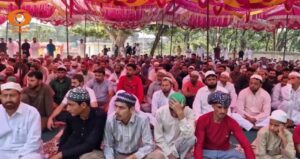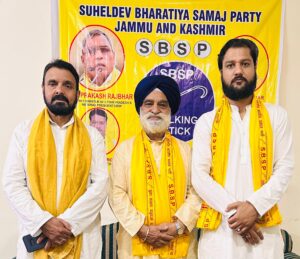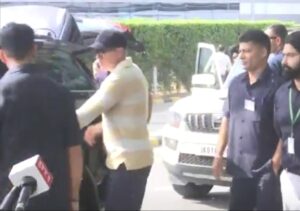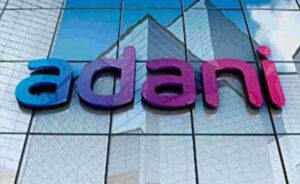Top polluted cities in the country: Union Minister of State for Environment, Forest and Climate Change Shri Ashwini Kumar Choubey in a written reply in the Rajya Sabha today

The Ministry provides ranking of better performing cities every year under “Swachh Vayu Sarvekshan” for 131 cities/ULB’s covered under National Clean Air Program (NCAP) based on the framework for taking various measures to abate pollution from solid waste, control of road dust, construction and demolition waste, vehicular emissions, industrial emissions including improvement in PM10 concentrations.
Ambient Air Quality monitoring is carried out in 518 cities/towns of the country. Details of Ambient Air Quality data in 5 cities/towns having highest PM10 levels measured during the year 2022 is placed at Annexure-I.
With a view to abate and control air pollution in Delhi / NCR, the Commission for Air Quality Management in NCR and Adjoining Areas (CAQM), constituted in 2021, has devised a comprehensive policy for abatement of pollution in NCR in July, 2022, stipulating sector specific action points quantifying targets along with timelines and implementation plan by various agencies in NCR States. The policy framework details sector-wise interventions, quantified targets and timelines for various sectors viz. vehicular pollution, industrial pollution, dust from construction and demolition project activities, road and open areas dust, biomass burning, agricultural stubble burning, Municipal Solid Waste burning, fires in sanitary landfills and air pollution from dispersed sources etc.
Since inception the CAQM has so far issued 78 directions and 11 advisories, besides executive orders to various agencies concerned in the NCR including State Governments of Punjab, GNCTD, and various bodies of the Central and State Governments in the region. Due to these concerted efforts general improvements in the AQI level has been witnessed in the region.
To address the deterioration of air quality, actions under ‘Graded Response Action Plan (GRAP)’ are also imposed based on AQI. The GRAP calls for a set of emergent preventive/restrictive actions depending on air pollution levels, to be implemented by the identified agencies for combating the adverse air quality scenario generally prevailing in Delhi owing to unfavorable climatic and meteorological conditions during the winter months.
Further, steps taken by Central Government for air quality management and to abate air pollution in Delhi /NCR is enclosed as Annexure-II.
The Government has taken several steps for abatement of air pollution owing to crop residue burning in Delhi NCR including the State of Punjab which are mentioned in Annexure-III.
For taking action against the farmers indulging in stubble burning, the Ministry has notified the Commission for Air Quality Management in National Capital Region and Adjoining Areas (lmposition, Collection and Utilization of Environmental Compensation for Stubble Burning) Rules, 2023 dated 28th April, 2023 for imposition of environmental compensation for stubble burning incidents. CAQM has reported that enforcement actions against stubble burning have been taken by State Governments and Environmental Compensation of Rs. 2.51 crore was imposed in the state of Punjab and Rs. 0.46 crore in the state of Haryana.
Ministry of Agriculture and Farmers’ Welfare (MoA&FW) in 2018 launched a scheme for ‘Promotion of Agricultural Mechanization for In-Situ Management of Crop Residue in the States of Punjab, Haryana, Uttar Pradesh & NCT of Delhi’, under which financial assistance is provided to the farmers for purchase of crop residue management machinery and establishment of custom hiring centres (CHCs). During 2018-2022, total fund released to Delhi and other States under the said Scheme is Rs. 2440.07 crores using which, over 2 lakh crop residue machineries have been delivered to individual farmers and CHCs, and over 39,000 CHCs have been established. In 2022, the Scheme has been merged with Sub-Mission on Agricultural Mechanization (SMAM) and SMAM has been merged with Rashtriya Krishi Vikas Yojana (RKVY).
The state-wise number of crop residue management machines supplied to individual farmers and CHCs is as under:
| State/Agency | Number of Machines delivered to the individual farmers and Custom Hiring Centres | No. of Custom Hiring Centres Established | ||||||||
| 2018-19 | 2019-20 | 2020-21 | 2021-22 | Total | 2018-19 | 2019-20 | 2020-21 | 2021-22 | Total | |
| Punjab | 27747 | 23068 | 24540 | 10031 | 85386 | 3888 | 5140 | 12100 | 4275 | 25403 |
| Haryana | 10627 | 14078 | 15350 | 19052 | 59107 | 1194 | 1685 | 1345 | 2551 | 6775 |
| Uttar Pradesh | 23306 | 7054 | 13651 | 11700 | 55711 | 2300 | 1650 | 1652 | 1611 | 7213 |
| NCT of Delhi | 0 | 111 | 51 | 85 | 247 | 0 | 0 | 0 | 0 | 0 |
| Total | 61680 | 44311 | 53592 | 40868 | 200451 | 7382 | 8473 | 15106 | 8437 | 39391 |
The Central Government and the Sate Governments of Delhi and NCR States have been working closely for implementation of Central Government Schemes to stop crop residue burning.
Regular meetings of the Committee of Secretaries (CoS) with concerned Ministries and State Governments under the chairmanship of Cabinet Secretary are being held to review the progress made on the issue of Air Quality Management in Delhi & NCR.
Directions were issued by CAQM to the State Governments of Punjab, Haryana, Uttar Pradesh, Rajasthan and Government of NCT of Delhi to prepare detailed monitorable action plans, based on a framework formulated by CAQM for control/elimination of crop residue burning. Subsequently directions were issued to the states to strictly and effectively implement the revised action plan to prevent and control/eliminate paddy stubble burning.
ICAR- Indian Agricultural Research Institute (IARI) has developed a microbial consortium Pusa Decomposer for in-situ accelerated decomposition of stubble/parali. Pusa Decomposer has been put to use in the states of Uttar Pradesh, Delhi, Haryana and Punjab.
Annexure-I
Details of Ambient Air Quality data in 5 cities/towns each having highest PM10 levels measured during the year 2022
| S.N. | Name of the City and State / Union Territory | PM10 concentrations (µg/m3) |
| 1 | Jharia, Jharkhand | 281 |
| 2 | Brynihat, Assam | 257 |
| 3 | Saharsa, Bihar | 250 |
| 4 | Katihar, Bihar | 227 |
| 5 | Samastipur, Bihar | 220 |
Annexure – II
Steps for management of air quality in India & Delhi-NCR
Measures for control of vehicular emissions:
- Environment Compensation Charges introduced for commercial vehicles entering Delhi in compliance of Hon’ble Supreme Court order
- Operationalization of Eastern and Western Peripheral Expressways to divert non-destined traffic from entering Delhi
- Directions issued by CAQM to Government of NCT of Delhi and State Governments of Haryana, Rajasthan and Uttar Pradesh for migration of public transport services, especially buses in NCR to cleaner modes. All state govt. bus services between Delhi and any city/town in the states of Haryana, Rajasthan and Uttar Pradesh to be operated only through EV /CNG/BS-VI diesel w.e.f. 01.11.2023.
- Ban on 15 year old petrol and 10 year old diesel vehicles as per Hon’ble Supreme Court and Hon’ble NGT orders.
- Installation of VRS system at 3256 petrol pumps in Delhi-NCR in compliance with orders of Hon’ble Supreme Court and Hon’ble NGT.
Measures for control of industrial emission:
- Installation of Online Continuous Emission Monitoring System (OCEMS) in red category air polluting industries in Delhi-NCR
- Industrial units in Delhi have shifted to PNG/cleaner fuels and, operational units in NCR have shifted to PNG/Biomass.
- Directions issued for conversion of brick kilns to zig-zag technology in Delhi and NCR. A total of 3003 out of 4608 brick kilns have converted to zig-zag technology including 1762 kilns in Haryana, 1024 kilns in U.P. and 217 kilns in Rajasthan. Brick kilns not converted to zig-zag technology are not permitted to operate.
- In order to control DG set emissions, CPCB is also funding retrofitment/ upgradation of DG sets in Govt. hospitals in Delhi-NCR and guidelines have been issued in this regard.
- Ban on use of pet coke and furnace oil as fuel in NCR States since October 24, 2017.
- An approved fuel list is in force in Delhi-NCR w.e.f. 01.01.2023. Industries operating on only PNG or biomass are permitted in NCR, except for specific requirement of other fuels by specific industries owing to technical, technological and process requirements. Out of 7759 fuel based industries in NCR, 7449 have been shifted to approved fuels, with the balance 310 industries under closure.
- Stringent PM emission norms for biomass based boilers have been prescribed for compliance in NCR.
Construction & Demolition (C&D) Waste
- Directions issued to DPCC and NCR SPCBs to enforce installation of anti-smog guns and other dust control measures at C&D sites.
- Directions issued for setting up of a “Dust Control and Management Cell” by road owning/ maintaining/ construction agencies for monitoring and effective implementation of dust control measures in the NCR.
- Online monitoring mechanism (through web portal) introduced for monitoring compliance of dust mitigation measures for construction sites.
Technical Interventions in Delhi-NCR
- Trial study of various new technologies for control of air pollution have been got conducted by CPCB out of which encouraging results were observed in case of Dust Suppressant for control of emissions at construction sites and road dust. Advisory have been issued for use of dust suppressant by road owning and construction agencies in Delhi-NCR.
Close Monitoring & Ground level implementation in Delhi-NCR
- 40 teams have been deputed by CPCB since December 2021, to assist CAQM, for conducting incognito inspections of air polluting industries, C&D sites, DG sets in Delhi-NCR to check implementation status of pollution control measures and compliance of other provisions of the Air (P&CP) Act,1981. A total of 16824 units/ entities/ projects have been inspected as on January 25, 2024. Based on these inspections, CAQM has issued Closure Directions in 901 cases and out of these resumption orders have been issued in 736 cases while 88 cases are still under closure and cases of 77 balance units have been transferred to SPCBs / DPCC for final decision.
- Another 15 teams (other than the 33 teams for Punjab and Haryana) were provided to CAQM as Flying Squads for carrying out incognito inspections of units/activities in various sectors contributing to air pollution such as Industrial activities, Construction and Demolition projects, Unpaved roads, DG Sets etc. These have also been recalled and the original 40 teams are conducting inspections.
Regular Stakeholder Consultation, Public & Media Outreach
- CPCB has developed a mobile app i.e. SAMEER, where Real-time Ambient air quality data of various parameters including AQI is also given. Sameer app also facilitates the public in lodging of air pollution related complaints in NCR region and such complaints are assigned to various local agencies.
- Dedicated media corner, Twitter and Facebook accounts have also been created for public outreach.
- Complaint redressal on SAMEER app and social media platforms is monitored and redressal status is shared with respective agencies.
- Daily AQI status is shared on social media platforms. Various campaigns as well as informative posts related to air pollution, firecrackers, vehicular pollution, stubble burning, sustainable lifestyle, etc. are also posted regularly on social media platforms.
- CPCB issues a daily report comprising of AQI of Delhi and NCR towns, comparative AQI status, year-wise trends of PM concentration, hotspots for the day, AFE counts, contribution of stubble burning and meteorological forecast. This report is prepared based on the inputs available from various sources such as IMD, SAFAR, IARI, etc., and disseminated through CPCB website.
Regulatory Actions in Delhi-NCR
- Graded Response Action Plan (GRAP) was formulated for Delhi-NCR to tackle the issue of sudden rise in air pollution levels which was notified by MoEF&CC in January 2017 on recommendation of CPCB for implementation. A comprehensive review of actions listed under GRAP was carried out by CPCB in 2020 based on actions taken and improvement observed in air quality in recent years. Based on the inputs given by CPCB, the revised GRAP was published by CAQM and further directions were issued for its implementation. Actions listed for different AQI levels under GRAP are invoked from time to time by a sub-committee constituted by CAQM, having CPCB as a member.
- Directions prescribing measures for control of pollution from various sources such as implementation of RECD system/ dual fuel kits in DG sets, use of cleaner fuels in industries, shift to EV/ CNG/ BS VI diesel fuel in transport sector, implementation of dust control measures at C&D sites etc., have been issued by CAQM, wherein CPCB is also a member and provided technical inputs to CAQM. Further, policy to curb air pollution in NCR has also been formulated.
- Directions under Section 5 of the Environment (Protection) Act, 1986 issued on November 03, 2023 to Delhi-NCR SPCBs/ PCCs for strict implementation of actions prescribed under stages of GRAP invoked from time to time, in view of the deteriorated air quality situation in Delhi-NCR.
Annexure-III
Measures for control of emissions from Stubble Burning in Delhi-NCR:
- Under Central Sector Scheme on ‘Promotion of Agricultural Mechanization for in-situ management of Crop Residue in the States of Punjab, Haryana, Uttar Pradesh and NCT of Delhi’, agricultural machines and equipment for in-situ crop residue management are promoted with 50% subsidy to the individual farmers and 80% subsidy for establishment of Custom Hiring Centers. In 2022, the Scheme has been merged with Sub-Mission on Agricultural Mechanization (SMAM) and SMAM has been merged with RashtriyaKrishiVikasYojana (RKVY).
- The Commission for Air Quality Management in NCR and Adjoining Areas (CAQM) on 17.09.2021 directed the coal-based Thermal Power plants situated up to a radius of 300 Km of Delhi to co-fire biomass based Pellets, Torrefied Pellets/Briquettes (with focus on paddy straw) with Coal (up to 5-10%).
- Directions issued by CAQM to State governments of Punjab, Haryana and Uttar Pradesh to strictly and effectively implement framework and revised action plan to eliminate and control stubble burning.
- CPCB has framed guidelines for providing one time financial assistance for setting up of paddy straw based pelletization and torrefaction plants which may help in addressing the supply chain issues and the issue of open burning of paddy straw in agriculture fields in Northern Region. A maximum amount of Rs. 28 lakhs or 40% of the capital cost considered for plant and machinery of a 1 TPH plant, whichever is lower, shall be given as one-time financial support by CPCB, subject to a maximum total financial support of Rs. 1.4 crore per proposal. A corpus of Rs. 50 crores had been earmarked for utilisation through the guidelines. A total of 10 plants have been approved so far.
- An addendum to the above said CPCB Guidelines was also issued under which one-time financial assistance is provided to Municipal Corporations, Municipal Councils and ZillaParishads of the states of Punjab, Haryana, NCT of Delhi and NCR districts of Uttar Pradesh and Rajasthan, for establishing paddy straw based briquetting plants for use of briquettes for crematoria only.
- From 10.11.2023 to the end of harvesting season, 33 scientists of CPCB were deployed as flying squads for assisting the Commission for Air Quality Management in National Capital Region and Adjoining Areas (CAQM) for intensifying monitoring and enforcement actions towards prevention of paddy stubble burning incidents in 22 districts of Punjab and 11 districts of Haryana. The flying squads coordinated with the state Government/ nodal officers/ officers from respective Pollution Control Boards towards prevention and control of stubble burning in their respective districts and sending their daily reports to CAQM.
- CPCB on 30.01.2024 has issued directions under Section 18 (1) (b) of the Air (P&CP) Act, 1981 to all SPCBs/PCCs for comprehensive management of paddy straw and other agro-residues.
This information was given by Union Minister of State for Environment, Forest and Climate Change Shri Ashwini Kumar Choubey in a written reply in the Rajya Sabha today.





